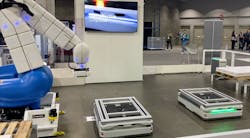A Mobile Robot for Matrix Production Setups
Integral to Industry 4.0 manufacturing operations is a focus on shorter response times and greater flexibility. To address this, KUKA has released its KMP 1500 autonomous mobile robot (AMR) which, as its name implies, has a payload capacity of up to 1500 kg.
According to KUKA, the KMP 1500 independently and autonomously handles the transport of products through all production process steps via its use of the KUKA omniMove drive technology, which allows the AMR to move in any direction from a standing position. The wheel technology used on the KMP 1500 reportedly allows for precise positioning with an accuracy of +/- 5 mm, even in tight spaces for highly precise logistics automation applications.
KUKA touts the KMP 1500’s suitability in matrix production setups, where workpieces and tools are transported by AMRs that navigate to the individual cells using a SLAM (simultaneous localization and mapping) navigation algorithm.
Matrix production, according to KUKA, is based on categorized and standardized production cells that can be arranged in virtually any way in a grid layout. Inside the cells, there are turntables for the setdown of parts, tool locations and robots which perform the relevant process. These production cells can be individually expanded with process-specific equipment such as for welding, adhesive bonding, punching and clinching.
In an application example highlighted by KUKA, the KMP 1500 AMR picks up the workpieces on arrival in the cell. The AMR can pick up and transport the different workpieces or tools using individually configurable load handling attachments.
These workpieces are then machined using intelligent robotic applications, such as jigless bodyshop technology where one robot holds one part while a second robot holds the other part. Both parts are locked together to form a unit which is then welded by the third robot. The workpieces are stored in the warehouse while the dedicated tools are located in the tool store. Logistics processes and production are separated from one another in matrix production, which KUKA notes is a central requirement of Industry 4.0. This matrix concept means that, with variable parts logistics, the system is always able to respond flexibly to production peaks and to divert AMRs to other cells as needed.
Features of the KMP 1500 include:
- Four emergency stops, a blinker to indicate the direction of travel, an LED signaling lamp and two laser scanners with safety and warning sensors for 360-degree monitoring.
- A rechargeable Li-ion battery pack with 54 Ah capacity and a minimum operating time of three hours. It can be charged via direct cable or floor contact plate.
- Wireless interfaces for configuration and programming enable remote control of the AMR.
- KUKA Navigation Solution Basic—this navigation system enables the mobile platform to navigate autonomously without risk of collision and without artificial markings.
- The KUKA omniMove drive technology is based on the Mecanum wheel allows the KMP 1500 to move in any direction.
In the video below, Tyler Britcher of KUKA Robotics explains the company’s exhibit at Modex 2024 which highlighted the KMP 1500.

